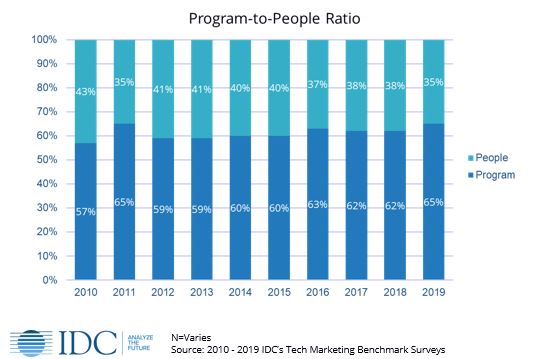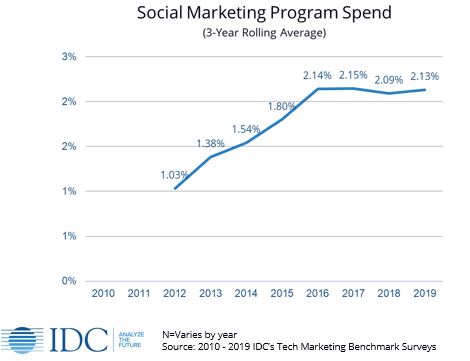2020 has certainly been a disruptive year for all facets of business, including marketing. However, it also marks a milestone for IDC: it concludes an entire decade of measuring technology marketing trends and priorities in the CMO Advisory Tech Marketing Benchmark Survey. As we look back at the past ten years of marketing trends, we can extrapolate what the next decade holds for marketers.
A Look Back at Marketing in 2010
At the start of the last decade, companies were beginning to pull themselves up from the Great Recession of 2008. Marketing budgets were just starting to recover; marketing budgets have historically been seen as the largest pools of “discretionary” funds for technology companies and the first place to make cuts when facing multi-quarter shortfalls, as these firms did during the recession.
2010 was also an interesting year for marketers, as this year represented a real shift towards digital marketing opportunities. Marketers discovered that digital mediums are often less expensive and easier to measure in terms of performance. However, the number of channels available to promote go-to-market messaging felt overwhelming. There were too many voices, too many messages and options to choose from. Marketers had to become savvier to distinguish themselves from the noise.
The 4 Biggest Things to Happen to Marketing in the Past Decade
1. Marketing Expanded Its Role
Marketing has gotten more staff and responsibilities over the past ten years. Although marketing is a relatively small department as a percentage of total staff, this ratio has risen 33% in the last decade. IDC finds that the absolute average number of marketers has increased, too.
During the past decade, tech companies also built up their MarTech stacks, making the marketing staff more productive. The combination of these two factors demonstrates that marketing is doing significantly more work. One significant area of expansion is that marketing is working deeper in the revenue pipeline than in the past. Business development reps, for example, are increasingly likely to report to marketing instead of sales.
Due to this increase in scope and staff, marketing budgets have grown as well. Between 2010 and 2019, marketing received an increased in investment every year except 2013. The last few years have been particularly rich. In 2019, the average marketing budget ratio at 2.6% is at its highest since 2008.
2. Digital Marketing Became Dominant
As the decade progressed, so too did the shift towards digital marketing programs and channels. From 2012 to 2015, the average Program-to-People investment ratio was roughly 60% program and 40% people. Starting in 2016, program investment increased within this ratio. Part of this shift happened because with the increase in digital marketing, staff productivity increased, making it easier to do more with fewer people. However, as marketing got incremental raises, additional budget went primarily to programs.

3. Content Marketing Significantly Expanded
While content marketing as a concept existed prior to 2010, it really took off over the past 10 years. This rise was directly caused by the increase in digital marketing. Successful digital marketing required companies to seed free content to attract prospects and build their brand. During the decade, customers fell in love with free content. In IDC’s 2019 IT Buyer Experience survey, 89% of tech buyers said that thought leadership content about solving their challenges would have a greater influence over their future decisions about which vendors and products they would choose.
The macro trends we’ve seen in technology marketing also show up specifically in content marketing trends. Spending on content marketing programs have risen steadily over the past decade, even as the total number of content marketing staff has decreased in-house. However, while the number of content marketers has decreased, the creative and brand services staff has increased 60% over the past 5 years, according to IDC’s benchmark. The larger creative staff then serves to assist these experts to present their work optimally.
Marketing leaders told IDC that in-house content idea development, writing, and speaking is dispersed among company experts, product marketers, and other thought leaders rather than housing them in one department. Additionally, need for interesting content has driven marketing to supplement internal efforts with professional content created by experts. This requirement drove up content’s program-related expenses.
4. Influencers Became Even More Important
While social media influencers are certainly a buzzworthy consumer marketing tactic, the fact still remains that analysts, influencers, and customers are critically important to tech marketing. Younger tech buyers increasingly rely on peers and the crowds for their buying advice. Marketers must influence the crowd and the crowd will influence the buyer.
To that effect, over the earlier part of the decade, social marketing program investment increased significantly, although it has recently flattened. Possibly the flattening is related to better management technology, or a shift to paid social.

What Comes Next for Tech Marketing
Will 2020 and the coronavirus pandemic end this period of expansion? Overall, the likely answer is yes. Due to economic uncertainty, the decrease in event spending, and the shift in the context of demand building, IDC expects a slowdown in the average marketing budget this year – a freeze for some companies and a decline for others. However, some tech companies will continue to expand marketing during this crisis.
The pandemic has pushed years of transformation through in a few weeks. The new decade of technology marketing began with a shock to the system, one that companies will be feeling for some time to come. However, while crises bring uncertainty, they also open space for opportunity and innovation. Crises accelerate innovation.
Broad brushstrokes of the new-normal are already on the wall. Operational processes will be substantially more digitized. For marketing, the processes to pay attention to are events and commerce (aka sales). The importance of customer empathy has gone from a buzzword to a business mandate. From a management perspective, a long-term shift to remote working and collaboration is expected. Although we can’t forecast the depth of these realities nor the details of how they will play out, practical leaders will embrace them – even where painful – rather than resist them.
The changes accelerated by the pandemic will be infused with influences already in play. When making strategic decisions, marketing leaders must also consider the compounding impact of macro drivers that were already propelling changes for marketing investments and staff.
Moving forward into the next decade of business, technology marketers will need have a seat at the strategy table not just for their department, but for the entire organization. They will be tasked with establishing their company’s brand with customers, prospects, and industry experts; they will take on more responsibility for the customer’s experience across the journey; they will need to work closely with sales and revenue teams to fill the sales pipeline and close deals; and they will be increasingly involved in post-purchase activities, such as loyalty and renewals. It’s a lot to handle. Emerging technology suppliers – and their marketing teams – can benefit from the right partnership with industry experts to help guide these strategic endeavors. Learn more about IDC’s innovative Accelerator Program, and how it uniquely positions IDC to be the partner of choice for disruptive technology suppliers to guide them through their growth trajectory:




